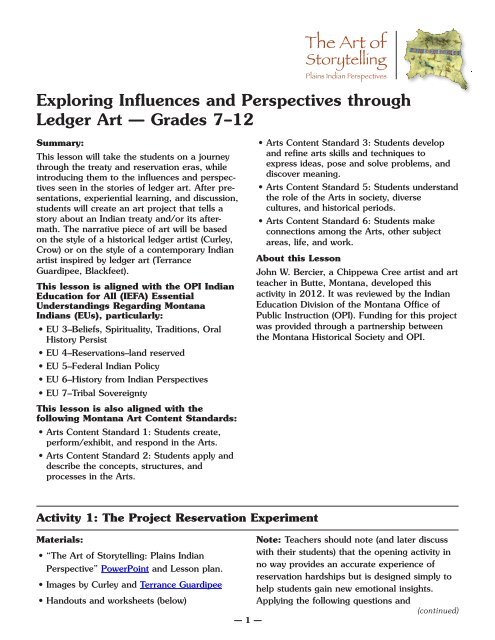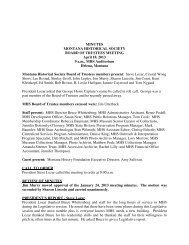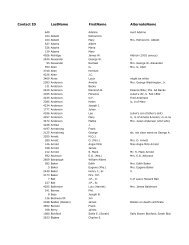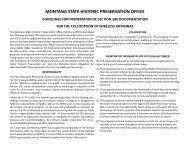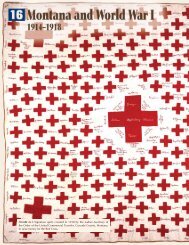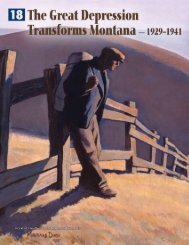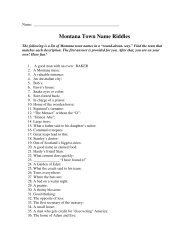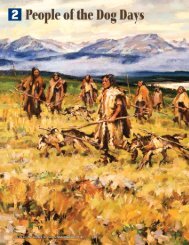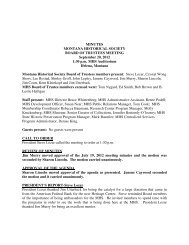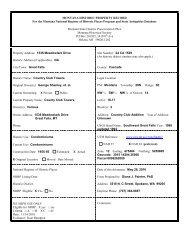Grades 7–12 - Montana Historical Society
Grades 7–12 - Montana Historical Society
Grades 7–12 - Montana Historical Society
Create successful ePaper yourself
Turn your PDF publications into a flip-book with our unique Google optimized e-Paper software.
Exploring Influences and Perspectives through<br />
Ledger Art — <strong>Grades</strong> <strong>7–12</strong><br />
Summary:<br />
This lesson will take the students on a journey<br />
through the treaty and reservation eras, while<br />
introducing them to the influences and perspectives<br />
seen in the stories of ledger art. After presentations,<br />
experiential learning, and discussion,<br />
students will create an art project that tells a<br />
story about an Indian treaty and/or its aftermath.<br />
The narrative piece of art will be based<br />
on the style of a historical ledger artist (Curley,<br />
Crow) or on the style of a contemporary Indian<br />
artist inspired by ledger art (Terrance<br />
Guardipee, Blackfeet).<br />
This lesson is aligned with the OPI Indian<br />
Education for All (IEFA) Essential<br />
Understandings Regarding <strong>Montana</strong><br />
Indians (EUs), particularly:<br />
• EU 3–Beliefs, Spirituality, Traditions, Oral<br />
History Persist<br />
• EU 4–Reservations–land reserved<br />
• EU 5–Federal Indian Policy<br />
• EU 6–History from Indian Perspectives<br />
• EU 7–Tribal Sovereignty<br />
This lesson is also aligned with the<br />
following <strong>Montana</strong> Art Content Standards:<br />
• Arts Content Standard 1: Students create,<br />
perform/exhibit, and respond in the Arts.<br />
• Arts Content Standard 2: Students apply and<br />
describe the concepts, structures, and<br />
processes in the Arts.<br />
Materials:<br />
• “The Art of Storytelling: Plains Indian<br />
Perspective” PowerPoint and Lesson plan.<br />
• Images by Curley and Terrance Guardipee<br />
• Handouts and worksheets (below)<br />
• Arts Content Standard 3: Students develop<br />
and refine arts skills and techniques to<br />
express ideas, pose and solve problems, and<br />
discover meaning.<br />
• Arts Content Standard 5: Students understand<br />
the role of the Arts in society, diverse<br />
cultures, and historical periods.<br />
• Arts Content Standard 6: Students make<br />
connections among the Arts, other subject<br />
areas, life, and work.<br />
About this Lesson<br />
Activity 1: The Project Reservation Experiment<br />
The Art of<br />
Storytelling<br />
Plains Indian Perspectives<br />
John W. Bercier, a Chippewa Cree artist and art<br />
teacher in Butte, <strong>Montana</strong>, developed this<br />
activity in 2012. It was reviewed by the Indian<br />
Education Division of the <strong>Montana</strong> Office of<br />
Public Instruction (OPI). Funding for this project<br />
was provided through a partnership between<br />
the <strong>Montana</strong> <strong>Historical</strong> <strong>Society</strong> and OPI.<br />
Note: Teachers should note (and later discuss<br />
with their students) that the opening activity in<br />
no way provides an accurate experience of<br />
reservation hardships but is designed simply to<br />
help students gain new emotional insights.<br />
Applying the following questions and<br />
(continued)<br />
— 1 —
The Art of Storytelling: Plains Indian Perspectives<br />
Exploring Influences and Perspectives through Ledger Art — <strong>Grades</strong> <strong>7–12</strong> (continued)<br />
understandings through discussion, inquiry, and<br />
activities will provide the cultural context for<br />
critical thinking and depth of learning.<br />
Procedure:<br />
Before class the teacher outlines several areas of<br />
the room by placing tape on the floor. These<br />
areas should be various sizes, with some small<br />
enough to make it difficult or uncomfortable for<br />
students to perform required tasks. Chairs<br />
should be removed or pushed aside.<br />
On Day 1, divide students into groups (same<br />
number as taped-off areas in the classroom) and<br />
appoint a leader for each group. Hand the leader<br />
a treaty written in Greek (Handout 1). This is to<br />
give an example of language barriers and the<br />
difficulties this caused during treaty negotiations.<br />
Tell the students that the agreement explains the<br />
art assignment, that they need to sign it in order<br />
to participate, and that they will receive a 0 for<br />
the assignment if they do not sign the paper.<br />
After collecting the treaties, tell students that<br />
they have actually signed an agreement to stay<br />
within a confined area indefinitely. The actual<br />
document in Greek reads: “Whereas, my teacher<br />
has my ultimate good at heart and understands<br />
what I need to develop as a student, human<br />
being and artist, Therefore, I agree to stay within<br />
the confined area established by my teacher. I<br />
understand that I will need to stay there<br />
indefinitely. In exchange, I will gain insight and<br />
an educational experience that will deepen my<br />
understanding of Indian history.”<br />
Send each group to one of the taped-off areas.<br />
The environment within the area bordered with<br />
tape should be unpleasant and create difficulties<br />
for the group to draw and take notes. The<br />
students will be standing and documenting<br />
during the presentation. (If the teacher makes<br />
one area big enough so that students can all sit,<br />
this will bring up issues of equity, reflecting the<br />
fact that reservations are not of equal size, and<br />
that some have more land base and are more<br />
resource-rich than others.)<br />
Once students are placed within their<br />
“reservations,” distribute worksheets and tell the<br />
students they must complete the worksheet<br />
despite any difficulties they may have with the<br />
space. (Teachers may want to experiment with<br />
the quantity and quality of supplies available<br />
within the confined area—this will make for<br />
great discussion and further discovery.)<br />
— 2 —<br />
Show PowerPoint and have students complete<br />
Worksheet 1.<br />
On Day 2, send students back to their assigned<br />
reservations and provide leaders Handouts 2-6,<br />
which define treaties and reservations and<br />
provide information on specific ledger artists.<br />
(One set of handouts for each group, or “tribe,”<br />
may create problems in interpersonal<br />
communication. This will raise questions about<br />
scarcity and stress and cooperation versus<br />
competition, all pertinent issues.)<br />
Require students to complete Worksheet 2.<br />
Worksheet 2 asks students to use the<br />
information from the handouts to create<br />
symbolic elements representing a series of key<br />
terms (for example, “reservation” and “treaty”).<br />
Each group will jointly create symbols for some<br />
key terms, while students will be individually<br />
responsible for creating symbols for other key<br />
terms. Explain to students that they will be using<br />
these symbols in their final art project (a ledger<br />
art–style illustration telling a historical story<br />
about an Indian treaty and/or its aftermath).<br />
Remind them that ledger artists often used<br />
symbols to represent larger ideas (e.g., dots<br />
showing the movement of men on foot) and that<br />
these symbols were shared and understood<br />
within tribes. (That’s why the group is jointly<br />
creating some symbols.) Ledger artists were also<br />
individuals with their own style, which is why<br />
students will create some individual symbols.<br />
What they don’t complete, assign as homework.<br />
On Day 3, allow students to return to their<br />
regular work stations and debrief. Teachers may<br />
want to ask students how it felt to be placed in<br />
the predefined areas, how it affected the quality<br />
of their work, what adaptations they had to<br />
make, and how it changed their thinking or<br />
emotional response to <strong>Montana</strong> Indian history as<br />
it relates to the Federal Indian Policy periods.<br />
After discussing the reservation experiment, look<br />
as a class at artwork created by Curley and<br />
Terrance Guardipee (images are on “The Art of<br />
Storytelling” website (mhs.mt.gov/education/<br />
IEFA/pictographicart.asp) and are also on the<br />
PowerPoint). Analyze each artistic style, make<br />
inferences about possible intentions,<br />
representation of symbols, etc. Then talk with<br />
students about the final art assignment: to create<br />
an art project, using predetermined symbols,<br />
that tells a story about an Indian treaty and/or<br />
its aftermath.<br />
(continued)
The Art of Storytelling: Plains Indian Perspectives<br />
Exploring Influences and Perspectives through Ledger Art — <strong>Grades</strong> <strong>7–12</strong> (continued)<br />
Activity 2: Telling a Story about Indian History through Art<br />
Materials:<br />
• Pencils, pens, and/or markers. (Printmaking<br />
on maps or ledger paper can be used for<br />
advanced methods.)<br />
• Heavy drawing paper, old maps, or copies of<br />
templates included on “The Art of<br />
Storytelling” website (mhs.mt.gov/education/<br />
IEFA/pictographicart.asp).<br />
• Completed worksheets from Activity 1.<br />
• Online Resources for Cultural and <strong>Historical</strong><br />
Background, Extension and Related Lessons<br />
(optional):<br />
• “Making Treaties,” Trailtribes.org (trailtribes.<br />
org/greatfalls/making-treaties.htm#lame)<br />
• “The Shrinking [Blackfeet] Reservation,”<br />
Interactive Map, Trailtribes.org (trailtribes.<br />
org/greatfalls/sites/showonecontent.asp@<br />
contentid3612.htm)<br />
• Washington State <strong>Historical</strong> <strong>Society</strong>’s “Treaty<br />
Trail Site,” October 17, 1855, Treaty with<br />
the Blackfeet page (washingtonhistoryonline.<br />
org/treatytrail/treaties/timeline/treaty_9.<br />
htm)<br />
• “A History and Foundation of American<br />
Indian Education Policy,” Stan Juneau,<br />
published by the <strong>Montana</strong> Office of Public<br />
Instruction, 2001, and available at opi.mt.<br />
gov/pdf/indianed/Resources/History_<br />
FoundationAmIndianPolicy.pdf)<br />
• “Two Worlds Collide, 1850-1887,”<br />
<strong>Montana</strong>: Stories of the Land (Helena,<br />
2008), available online at mhs.mt.gov/<br />
education/textbook/Chapter7/Chapter7.pdf<br />
Procedure:<br />
This final project builds on the Project<br />
Reservation Experiment. Remind students of<br />
their final assignment: to create an art project,<br />
using predetermined symbols, that tells a story<br />
about an Indian treaty and/or its aftermath. The<br />
narrative piece of art will be based on the style<br />
of a historical ledger artist (Curley, Crow) or on<br />
— 3 —<br />
the style of a contemporary Indian artist inspired<br />
by ledger art (Terrance Guardipee, Blackfeet).<br />
(Teacher may want to create a written<br />
assignment/rubric detailing his/her expectations.)<br />
Brainstorm with students and have them create<br />
concept sketches before they begin working on<br />
their final projects.<br />
Teachers may want students to engage in further<br />
historical research before beginning to sketch.<br />
Trailtribes.org (trailtribes.org) is a good website<br />
that provides useful but brief information on the<br />
Lame Bull’s 1855 treaty and its aftermath. Its<br />
interactive map, “The Shrinking Reservation,” is<br />
very powerful. Students may also be required to<br />
conduct more extensive research. The list,<br />
“Online Resources for Cultural and <strong>Historical</strong><br />
Background,” provided in the Materials section is<br />
a good starting point. Additional resources are<br />
listed at the end of this lesson plan in<br />
“Resources for Additional Research.”<br />
Evaluation or Assessment:<br />
Students will be evaluated or assessed on their<br />
demonstration of knowledge, understandings,<br />
skills, and abilities of the Essential<br />
Understandings, historical contexts, and Arts<br />
content as outlined in the learning objectives<br />
(below). Assessment will be based on how well<br />
the students answered the questions during the<br />
visual presentation, the level of inquiry, research,<br />
and the outcome of the art activities.<br />
The four performance levels included in the<br />
<strong>Montana</strong> Art Standards: Advanced, Proficient,<br />
Nearing Proficiency, and Novice.<br />
Objectives to Evaluate or Assess:<br />
Students will be able to:<br />
• Exchange ideas about the use of symbols to<br />
express abstract concepts.<br />
• Communicate an understanding of ledger art<br />
(whose perspective is seen and told) and its<br />
history, both verbally and through individual<br />
(or collaborative) artistic activity.<br />
(continued)
The Art of Storytelling: Plains Indian Perspectives<br />
Exploring Influences and Perspectives through Ledger Art — <strong>Grades</strong> <strong>7–12</strong> (continued)<br />
• Communicate significant facts about the treaty<br />
and reservation periods.<br />
• Discuss the perspective of storyteller and<br />
identify differences and similarities between<br />
the historical ledger art of Crow artist Curley<br />
and the contemporary art of Blackfeet artist,<br />
Terrance Guardipee.<br />
• Define “treaty,” “reservation,” and<br />
“sovereignty.”<br />
• Understand the Federal Indian Policy as it<br />
affected <strong>Montana</strong> Indians historically and the<br />
significance of how it still does today.<br />
Essential Student Questions:<br />
What are some of the ways the Federal Indian<br />
Policy periods affected the lives of individual<br />
Indians and their tribes?<br />
Resources for Additional Research:<br />
Timelines, <strong>Historical</strong> and Cultural<br />
Background:<br />
<strong>Montana</strong> and United States timelines, 1850–<br />
1900: Connecting Cultures and Classrooms,<br />
K-12 Curriculum Guide (Language Arts, Science,<br />
and Social Studies) see pp. 104–109. opi.mt.<br />
gov/pdf/indianed/ConnectingCultures.pdf<br />
Tribal Timelines: Crow, Cheyenne, Gros Ventre<br />
timelines: opi.mt.gov/pdf/IndianEd/IEFA/<br />
TribalHistoryTimelinesAll.pdf<br />
<strong>Montana</strong> Tribal Histories: Educators Resource<br />
Guide and Companion DVD. 2011, MT OPI, IE.<br />
Model Lesson Plans, Social Studies Winter 2006<br />
Images of American Indian Pictorial Style<br />
Art:<br />
Picturing America, NEH. (Most school libraries<br />
have this series): “Sans Arc Lakota” Ledger<br />
— 4 —<br />
How was the treaty-making process flawed? Why<br />
and in what way(s)?<br />
Whose perspective is told and seen in historical<br />
ledger art? How is this significant to the<br />
historical periods? How is it significant to the<br />
Essential Understandings Regarding <strong>Montana</strong><br />
Indians (EUs)? Is there one EU in particular?<br />
What are some ways Plains Indian artistic styles<br />
of historical ledger art impact contemporary<br />
ledger art?<br />
How does culture and art change in the face of<br />
larger historical forces? How are some aspects of<br />
culture and art preserved, regardless of these<br />
outside forces?<br />
How can symbols, style, perspective, and story<br />
be used effectively in narrative and contemporary<br />
ledger art?<br />
Book, 1880-1881 (Artist: Black Hawk); “Catlin<br />
Painting the Portrait of Mah-to-toh-pa—Mandan,<br />
1861/1869”<br />
University of California San Diego Plains Indian<br />
Ledger Art Project. plainsledgerart.org/<br />
National Museum of the American Indian: “A<br />
Song for the Horse Nation” nmai.si.edu/home/<br />
Museum of the Plains Indian www.doi.gov/iacb/<br />
museums/museum_plains.html<br />
Terrance Guardipee Blackfeet,<br />
terranceguardipee.com<br />
Kevin Red Star, Crow kevinredstar.com<br />
Extension and Related Resources and<br />
Lessons<br />
To find related OPI IE Model Lesson plans: opi.<br />
mt.gov/Programs/IndianEd/curricsearch.html
The Art of Storytelling: Plains Indian Perspectives<br />
<strong>Grades</strong> 7-12 Handout<br />
HAndouT 1<br />
Ότι,<br />
καθηγητής μου μου έχει απόλυτη επιτυχία στην καρδιά και<br />
καταλαβαίνει τι χρειάζομαι για να αναπτυχθεί ως φοιτητής, άνθρωπος<br />
και καλλιτέχνης,<br />
ως εκ τούτου, συμφωνώ να παραμείνει εντός του περιορισμένο χώρο<br />
που καθορίζεται από το διδάσκοντα.<br />
Κατανοώ ότι θα πρέπει να μείνουν εκεί επ' αόριστον. Σε αντάλλαγμα,<br />
θα αποκτήσουν γνώση και εκπαιδευτική εμπειρία που θα<br />
εμβαθύνουν την κατανόηση της Ινδικής ιστορίας.<br />
Υπογραφή (Signature):<br />
— 5 —<br />
The Art of<br />
Storytelling<br />
Plains Indian Perspectives
The Art of Storytelling: Plains Indian Perspectives<br />
<strong>Grades</strong> 7-12 Handout<br />
HAndouT 2: Treaties<br />
A treaty is an express agreement under international law entered into by actors in international law,<br />
namely sovereign states and international organizations. According to “Government to Government,”<br />
published by the National Congress of American Indians and National Council on State Legislatures<br />
(June 2000):<br />
When European settlers came to America, they dealt with the tribes as sovereigns and often<br />
negotiated treaties with them. Hundreds of treaties between Indian nations and the United States<br />
have been negotiated by the president and ratified by two-thirds of the Senate. Indian treaties<br />
have the same status as treaties with foreign nations. Because such treaties are made under the<br />
U.S. Constitution, they take precedence over any conflicting state law. . . Treaties vary widely in<br />
their terms and provisions. They commonly included a guarantee of peace, a provision of land<br />
boundaries, a guarantee of hunting and fishing rights, education of Tribal members, and a<br />
statement that the tribe recognized the authority of the United States and, in return, received a<br />
promise from the United States of protection.<br />
Treaties with tribes in <strong>Montana</strong> Territory did not begin until 1855, more than 70 years after the first<br />
treaties were negotiated in the eastern portion of the United States. According to Darrell Kipp, a<br />
Blackfeet tribal historian and language specialist,<br />
The effect of the treaty period to tribes in <strong>Montana</strong> was the huge loss of millions of acres. As an<br />
example, when the Blackfeet Tribe signed the Treaty with the Blackfeet, 1855, they remained in<br />
control of about 28,000,000 acres; however, because of Presidential proclamations, treaties and<br />
agreements after 1855, the Blackfeet Tribe’s land base was reduced to its current 1.5 million<br />
acres. Viewing the loss of this land base from a different perspective, the locations of the Ft.<br />
Peck Indian Reservation, Ft. Belknap Indian Reservation and Rocky Boy Reservation, and all the<br />
land surrounding these reservations today, are located in what was the original Blackfeet<br />
Territory in 1855.<br />
Treaties between the U.S. government and Indian tribes ended in 1871 when Congress passed a<br />
legislative rider that attempted to limit the power of the president to enter into treaties with Indian<br />
nations. Since 1871 the president has recognized and given federal status to other Indian tribes and<br />
established new reservation boundaries through Presidential Executive Orders. Indian tribes in<br />
<strong>Montana</strong> would again lose large areas of their land bases because of Presidential Executive Orders.<br />
(Excerpted from “A History and Foundation of American Indian Education Policy,” Stan Juneau,<br />
published by the <strong>Montana</strong> Office of Public Instruction, 2001, and available at http://www.opi.mt.<br />
gov/pdf/indianed/Resources/History_FoundationAmIndianPolicy.pdf)<br />
The Trouble with Treaties<br />
While treaties recognized Indian sovereignty, there were many problems associated with treaties and<br />
treaty negotiations. According to <strong>Montana</strong>: Stories of the Land (Helena, 2008), 126:<br />
— 6 —<br />
The Art of<br />
Storytelling<br />
Plains Indian Perspectives<br />
(continued)
The Art of Storytelling: Plains Indian Perspectives<br />
<strong>Grades</strong> K-3. 4-6 amd <strong>7–12</strong>. Handout 2: Treaties (continued)<br />
There were four basic problems with the treaties. First, the treaties were based on the Euro-<br />
American idea that land could be bought and sold. Plains and Plateau Indian tribes fought to<br />
control territory, but they did not believe that land was something an individual or tribe could<br />
own, much less buy or sell. In most Plains Indian traditions, the land was the supreme provider<br />
of all life. It was literally made up of the blood and bones of the people’s ancestors. These<br />
opposing ideas led to many conflicts over the land.<br />
Another problem was the language difference. U.S. government representatives spoke English;<br />
tribal leaders each spoke their own tribal language. Every idea had to go through several<br />
translations—and often the translators were not very skillful. So there were many<br />
misunderstandings.<br />
A third problem was that government representatives misunderstood the structure of Indian<br />
tribes. They assumed that Indian chiefs could speak for their people the way a U.S. president<br />
could do. But this was not the way tribes organized themselves. Different tribes had different<br />
political structures. Individual bands had military leaders, political leaders, and spiritual leaders.<br />
The people looked to these chiefs for their wisdom and experience, but they were not necessarily<br />
obligated to do what they said.<br />
Sometimes negotiators for the U.S. side took advantage of this loose organization of tribal<br />
leaders. If one chief refused to sign a treaty, the negotiators would simply find a different chief<br />
who would sign. But the government still expected all tribal members to comply with the treaty,<br />
no matter which chief signed. Then, if some bands or individual tribal members did not comply<br />
with terms of the treaties, the U.S. government sent in military troops to force them to comply.<br />
The fourth big problem with the U.S.–Indian treaties was that the U.S. government often did not<br />
live up to its agreements. It allowed white settlers to trespass on Indian land that it had promised<br />
in the treaties to protect. It paid tribes in supplies they did not need. Or it sent low quality,<br />
spoiled food and broken equipment. And corrupt government contractors and agents often<br />
simply stole tribal money. Sometimes new administrations ignored deals negotiated by earlier<br />
government officials. A few times Congress refused to ratify (formally approve) treaties that had<br />
already been signed. Congress often changed the terms of treaties after they were signed—<br />
without informing the tribes.<br />
Treaty with the Blackfeet, 1855<br />
<strong>Montana</strong> Indians negotiated many treaties and agreements. One of the treaties that affected and still<br />
does affect the Blackfeet is the Treaty with the Blackfeet, 1855 (Lame Bull Treaty).<br />
Information about the 1855 Treaty with the Blackfeet can be found on the page “Making Treaties,”<br />
on Trailtribes.org (trailtribes.org/greatfalls/making-treaties.htm#lame). The full text of the treaty can<br />
be found on the Washington State <strong>Historical</strong> <strong>Society</strong>’s “Treaty Trail Site,” October 17, 1855, Treaty<br />
with the Blackfeet page (washingtonhistoryonline.org/treatytrail/treaties/timeline/treaty_9.htm). The<br />
website also provides useful background information on Isaac Stevens, the U.S. negotiator.<br />
— 7 —
The Art of Storytelling: Plains Indian Perspectives<br />
<strong>Grades</strong> 7-12 Handout<br />
HAndouT 3: Reservations<br />
Current <strong>Montana</strong> Reservations<br />
Tribal Homelands, 1855<br />
— 8 —<br />
The Art of<br />
Storytelling<br />
Plains Indian Perspectives<br />
(continued)
The Art of Storytelling: Plains Indian Perspectives<br />
HANDOUT 3: Reservations (continued)<br />
Reservations are lands that have been reserved by the tribes for their own use through treaties,<br />
statutes, and executive orders and were not “given” to them. The principle that land should be<br />
acquired from the Indians only through their consent with treaties involved three assumptions:<br />
I. Both parties to treaties were sovereign powers.<br />
II. Indian tribes had some form of transferable title to the land.<br />
III. Acquisition of Indian lands was solely a government matter not to be left to individual colonists.<br />
Indian Nations located in <strong>Montana</strong> Territory prior to the passage of the <strong>Montana</strong> Constitution in<br />
1889 held large land bases as negotiated through their treaties with the United States. The treaties<br />
assigned tribes to certain areas and obligated them to respect the land of their neighbors. However,<br />
in the 1860s, as miners and others rushed into the prime gold fields that often lay along or within<br />
the designated tribal lands, tribal life was disrupted. The new inhabitants demanded federal<br />
protection. These demands resulted in the garrisoning of <strong>Montana</strong> and the eventual relocation of the<br />
tribes to smaller and smaller reserves.<br />
The federal government and many <strong>Montana</strong> citizens did not understand the lifestyles of <strong>Montana</strong>’s<br />
Indian tribes. Consequently, communication with the tribes was often through non-Indian<br />
perspectives, expectations, and points of view. However, the federal government did understand that<br />
these tribal groups were sovereign nations and that the United States needed to enter into treaty<br />
negotiations with the tribes.<br />
— 9 —
The Art of Storytelling: Plains Indian Perspectives<br />
<strong>Grades</strong> 7-12 Handout<br />
HAndouT 4: Sovereignty<br />
Excerpted from the <strong>Montana</strong> Office of Public Instruction’s Essential Understandings Regarding<br />
<strong>Montana</strong> Indians, opi.mt.gov/pdf/indianed/resources/essentialunderstandings.pdf, p. 7.<br />
Under the American legal system, Indian tribes have sovereign powers, separate and independent<br />
from the federal and state governments. However, the extent and breadth of tribal sovereignty is not<br />
the same for each tribe.<br />
Background<br />
Before colonization, Indian tribes possessed complete sovereignty. Within the governmental structure<br />
of the United States and the complex history of tribal-federal relations, tribes are now classified as<br />
domestic dependent nations. This means tribes have the power to define their own membership,<br />
structure and operate their tribal governments, regulate domestic relations, settle disputes, manage<br />
their property and resources, raise tax revenues, regulate businesses, and conduct relations with<br />
other governments. It also means that the federal government is obligated to protect tribal lands and<br />
resources; protect the tribes’ right to self-government; and provide social, medical, educational, and<br />
economic development services necessary for the survival and advancement of tribes (Echohawk).<br />
A very important but often unappreciated point is that tribal sovereignty does not arise out of the<br />
U.S. government, congressional acts, executive orders, treaties, or any other source outside the<br />
tribe. As Felix Cohen puts it, “perhaps the most basic principle of all Indian law... is that those<br />
powers which are lawfully vested in an Indian tribe are not, in general, delegated powers granted by<br />
expressed acts of Congress, but rather inherent powers of a limited sovereignty, which has never<br />
been extinguished” (Cohen 122).<br />
Sovereignty can be defined as “The supreme power from which all political powers are derived.” It is<br />
inherent—it cannot be given to one group by another. In government-to-government negotiations,<br />
states and Indian nations exercise or use their sovereign powers.<br />
“Sovereignty ensures self-government, cultural preservation, and a people’s control of their future.<br />
Sovereignty affirms the political identity of Indian Nations—they are not simply a racial or ethnic<br />
minority” (Chavaree).<br />
Citations<br />
Chavaree, Mark A. Esq., “Tribal Sovereignty,” Wabanaki Legal News, Volume 2, Issue 1, Winter,<br />
1998.<br />
Cohen, Felix S. Ch. 7 “Sect. 1, Introduction - The Scope of Tribal Self-Government.” Handbook of<br />
Federal Indian Law. U.S. Government Printing Office. 1945. 4th Printing. See: thorpe.ou.edu/,<br />
Cohen’s Handbook. p. 122.<br />
Echohawk, John E. “From the Director’s Desk.” Justice Newsletter. 2000. See: narf.org/pubs/<br />
justice/2000fall.html<br />
— 10 —<br />
The Art of<br />
Storytelling<br />
Plains Indian Perspectives
The Art of Storytelling: Plains Indian Perspectives<br />
<strong>Grades</strong> 7-12 Handout<br />
HAndouT 5: Curley<br />
(c. 1856–1923), Crow<br />
As Euro-Americans moved West, Indians in <strong>Montana</strong> were losing their old ways of life. During this<br />
time many Indian people wanted to remember the old ways, so they drew them from memory,<br />
using the materials that were available to them. These new materials included different kinds of<br />
paper, like notebook paper or paper from books that kept track of sales in stores and the railroad<br />
(ledger books). They used pencils and colored pencils to draw their stories—the same sorts of<br />
stories that they had traditionally drawn on tipi liners and robes.<br />
Curley, Crow Indian Scout, General<br />
Custer’s Scout (Crow), 1883<br />
Photograph by F. J. Haynes,<br />
(1853–1921)<br />
<strong>Montana</strong> <strong>Historical</strong> <strong>Society</strong> Research<br />
Center Photograph Archives, Haynes<br />
Foundation Collection, H-936<br />
One of <strong>Montana</strong>’s ledger artists was Curley, a Crow Indian<br />
warrior who also served as a U.S. scout during the Battle of<br />
the Little Bighorn. In the photograph here, Curley is shown<br />
wearing the White Swan robe—decorated with both<br />
beadwork and pictographic drawings representing battle<br />
scenes. White Swan, who was Crow, painted the lower half<br />
of this beautiful robe. A different artist, or artists, painted<br />
the battle scene in the upper half of this robe. That artist<br />
may have been Curley since the composition of several of<br />
the warriors’ feet, arms, and faces resemble warriors in<br />
ledger artwork attributed to him.<br />
As an artist, Curley utilized a unique and lively graphic style<br />
by portraying warriors with elongated bodies, small curved<br />
feet, and no hands. His artwork reflects the continuity<br />
between traditional hide painting and ledger art. Similarly,<br />
his biography reflects the continuity of Crow culture and<br />
traditions and adaptation to the new realities of U.S.<br />
hegemony.<br />
Curley was born in approximately 1856 in <strong>Montana</strong><br />
Territory, the son of Strong Bear (Inside the Mouth) and<br />
Strikes By the Side of the Water. His Crow name, variously<br />
rendered as Ashishishe, Shishi’esh, etc., literally means “the<br />
Crow.” He resided on the Crow Reservation in the vicinity of<br />
Pryor Creek and married Bird Woman. He enlisted in the<br />
U.S. Army as an Indian scout on April 10, 1876.<br />
Curley later lived on the Crow Reservation on the banks of the Little Bighorn River. He served in<br />
the Crow Police. He divorced Bird Woman in 1886 and married Takes a Shield. Curley had one<br />
daughter, Awakuk Korita ha Sakush (“Bird of Another Year”), who took the English name Nora.<br />
For his army service Curley received a U.S. pension starting in 1920. He died of pneumonia in<br />
1923, and his remains were interred in the National Cemetery at the Little Bighorn Battlefield<br />
National Monument, only a mile from his home.<br />
— 11 —<br />
The Art of<br />
Storytelling<br />
Plains Indian Perspectives
The Art of Storytelling: Plains Indian Perspectives<br />
<strong>Grades</strong> 7-12 Handout<br />
HAndouT 6: Terrance Guardipee<br />
Terrance Guardipee (born 1968), Blackfeet<br />
Terrance Guardipee is an internationally acclaimed Blackfeet painter and ledger artist, consistently<br />
recognized for the traditional depiction of his Blackfeet heritage and contemporary innovation<br />
demonstrated in his work. Guardipee was one of the first American Indian artists to revive the<br />
historical ledger art tradition and was the first ledger artist to transform the style from the single<br />
page custom into his signature map collage concept. In all his artwork, Guardipee utilizes antique<br />
documents dating from the mid-nineteenth century and typically originating from the historical and<br />
present-day Blackfeet homeland in <strong>Montana</strong>.<br />
Terrance Guardipee lived in <strong>Montana</strong> until he attended the Institute of American Indian Arts located<br />
in Santa Fe, New Mexico, where he studied two-dimensional arts. His educational experience at IAIA<br />
enabled him to incorporate the contemporary color palate he is known for in a manner that is<br />
consistent with Blackfeet tradition. Presently, Guardipee lives in Seattle, Washington.<br />
Guardipee’s innovative artwork is featured in the permanent collections of prestigious institutions<br />
such as the Smithsonian Institute, the Gene Autry Museum, the Hood Museum at Dartmouth<br />
College, and the Museum of Natural History in Hanover, Germany. Furthermore, Guardipee was the<br />
featured artist at the National Museum of the American Indian in 2007, and was selected to create<br />
an image for The Trail of Painted Ponies at the 2008 50th Anniversary Heard Museum Indian Art<br />
Market. The leading institutions in the Native art community consistently acknowledge Guardipee’s<br />
innovative incorporation of authentic Blackfeet images into his own contemporary form of art.<br />
— 12 —<br />
The Art of<br />
Storytelling<br />
Plains Indian Perspectives
The Art of Storytelling: Plains Indian Perspectives<br />
<strong>Grades</strong> 7-12 Worksheet<br />
WoRkSHEET 1<br />
Answer the following questions.<br />
1. What types of topics were addressed in men’s pictographic art?<br />
2. Define ledger art.<br />
3. Name one thing that distinguishes Blackfeet ledger art from Cheyenne ledger art.<br />
4. List three symbolic elements pictographic artists commonly use<br />
(e.g., horseshoes to represent horses).<br />
— 13 —<br />
The Art of<br />
Storytelling<br />
Plains Indian Perspectives
The Art of Storytelling: Plains Indian Perspectives<br />
<strong>Grades</strong> 7-12 Worksheet<br />
WoRkSHEET 2<br />
As a group, create visual symbols representing the following terms/concepts using<br />
information you remember from the PowerPoint and information from your handouts.<br />
Treaty<br />
Reservation<br />
Sovereignty<br />
As individuals, create visual symbols representing four terms/concepts relating to Indian<br />
history from this list or four other terms that are meaningful and appropriate for the<br />
project. If you can’t create a symbol quickly in class, take notes that will allow you to create<br />
the symbol for homework. Remember: You will be using these symbols in a narrative piece<br />
of art that tells the story of a treaty and/or its aftermath.<br />
Annuity<br />
Negotiation<br />
Assimilation<br />
Tribal leader or chief<br />
Scarcity<br />
Starvation<br />
U.S. negotiator<br />
Congress<br />
U.S. president<br />
Land loss<br />
— 14 —<br />
The Art of<br />
Storytelling<br />
Plains Indian Perspectives


